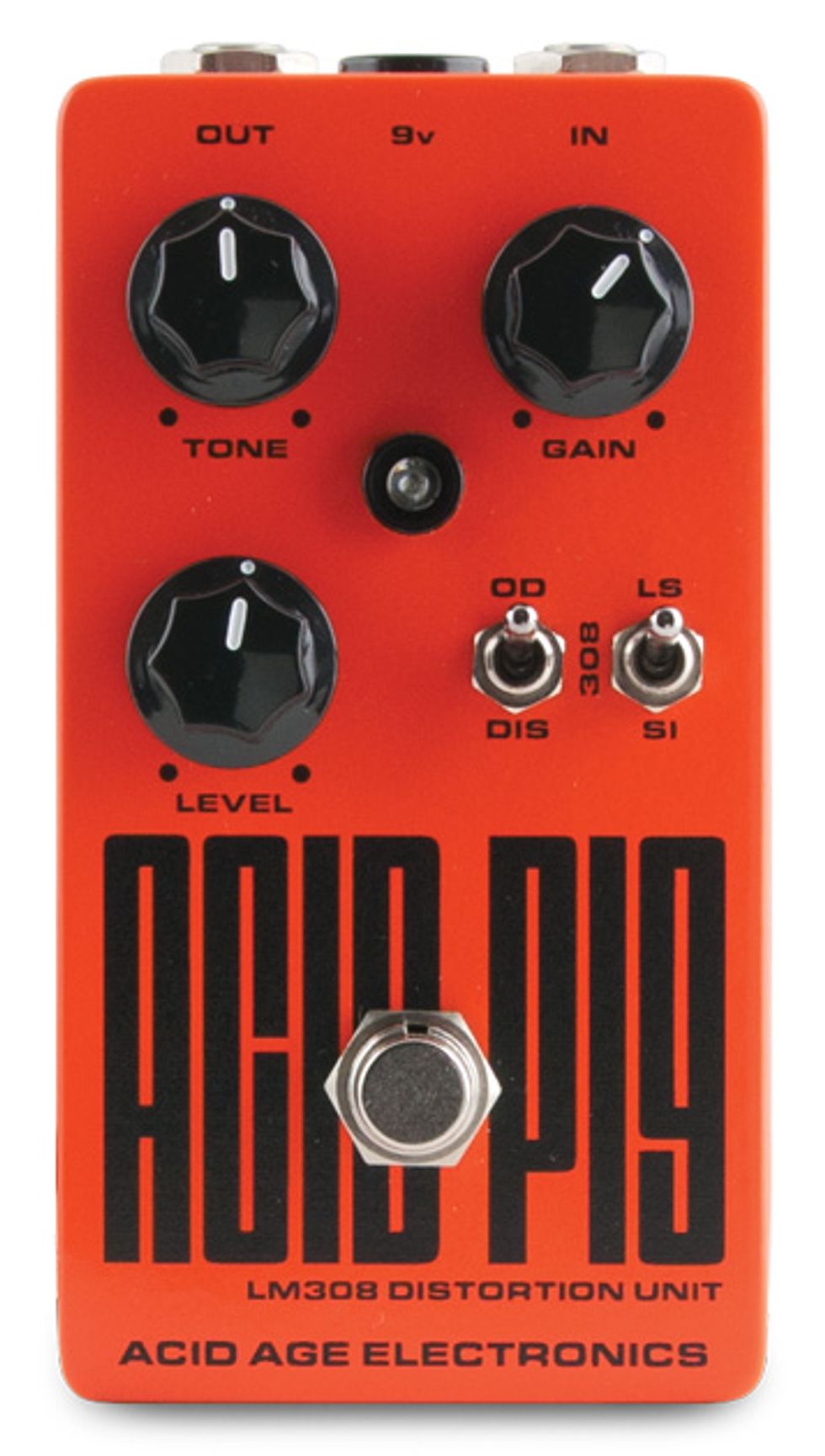This pedal’s full name is the Acid Pig LM308 Distortion Unit. The LM308 is a type of op amp (the integrated circuit that provides gain in most overdrive/distortion circuits). For crunchaholics, the LM308 connotes one particular pedal: the original ProCo Rat. Later Rat revisions featured different op amps along with other circuit changes. But for many fans of this potent and popular circuit, real Rats employ LM308s.
The Acid Pig is an excellent Rat reproduction, but it’s also more than just a clone. Like a number of current boutique Rat replicas, it expands the circuit’s range with modifications that can alter the distortion’s character and intensity. This is a retro Rat with improved range.
Rat on!
The Acid Pig resides in a standard 125B enclosure with top-mounted jacks. Internal construction is immaculate: Wires are neatly routed, soldering is flawless, and the PCB is secured to the housing via the Pig’s two switches. Either a 9-volt battery or a standard power supply (not included) can power the Pig.
The pedal’s three pots—gain, tone, and level—mirror the Rat. So do the tones when the switches are set to mimic the original circuit. (More on that in a moment.) The Pig sounds as good as any Rat I’ve heard. If you dig the Rat sound, you won’t be disappointed.
That sound is, for better or worse, strongly linked to ’80s hard rock, but you don’t have to love Ratt to love the Rat. Harder-edged than a Screamer and more tightly focused than a ’60s-style transistor-based fuzz, the core distortion sound lends itself to any aggressive guitar style requiring loud, bright distortion and strong note attack. The tone control is a simple treble roll-off, but it’s perfectly voiced to emphasize pick attack and dial in the right amount of edge. There’s massive gain range. The pedal can get insanely loud, yet it retains its essential character at modest output settings that don’t bludgeon your preamp—a great recipe for tight, chunky hard rock chords.
In fact, many modern metal and hard rock players will probably relate to the Pig. Even though the circuit that inspires it was created long before the drop-tuning and 7-string crazes, it kills on low-tuned strings. Drop-D sounds great. Baritone guitars in B or A sound great. Heck, even low-tuned bass guitars can sound great (though bassists are likely to long for a midrange tone control and a wet/dry blend).
On the other hand, the circuit is probably not a great choice for fans of warm/smooth distortion, or for players who like to sculpt tone via their guitars’ volume knobs. Rolling back a guitar’s volume a touch slims down the crunch, but you can’t really clean up the tone that way. Low guitar volume settings produce dark, tentative tones. The Pig prefers to rawk.
Ratings
Pros:
Excellent vintage Rat tones. Cool alternate sounds via diode switching.
Cons:
The tight, bright distortion doesn’t suit all styles.
Tones:
Playability/Ease of Use:
Build/Design:
Value:
Street:
$160
Acid Age Electronics
Acid Pig
Do or Diode
The Pig’s two switches provide four variations on the classic Rat tone by jiggering with the diode configuration. (Like Screamers, Rats generate distortion via a pair of diodes, though they’re inserted at a different point in the circuit, hence the Rat’s harder/edgier sound. In fact, the Rat’s circuit is surprisingly similar to that of the Boss DS-1.)
One of the three-way switch’s settings replicates the original Rat configuration (silicon diodes). Another mixes silicon with an LED, yielding even louder and tighter tones. A third option removes the diodes from the circuit altogether, generating distortion exclusively within the op amp. Diodes suck volume as they distort, so bypassing them triggers a hefty level boost. This setting has less character, but man, is it loud!
A second switch selects between overdrive and distortion modes. As you’d expect, the overdrive setting softens the Pig’s bite, though it’s still plenty aggressive. The switch provides attractive variations in both silicon and silicon/LED modes, though it has no effect when the diodes are bypassed.
The Verdict
The Acid Pig delivers stellar Rat-style distortion plus several cool and useful sonic variations. It costs nearly twice as much as a new Rat (which are now quite affordable but made overseas,) but it offers far more tones and comes packed with the coveted LM308 component that many Ratheads swear by. If you seek quality dirt, but find retro-style transistor fuzz too squishy and Screamers too tame, Acid Age Electronics may have built your perfect pigpen.








![Rig Rundown: Russian Circles’ Mike Sullivan [2025]](https://www.premierguitar.com/media-library/youtube.jpg?id=62303631&width=1245&height=700&quality=70&coordinates=0%2C0%2C0%2C0)

















